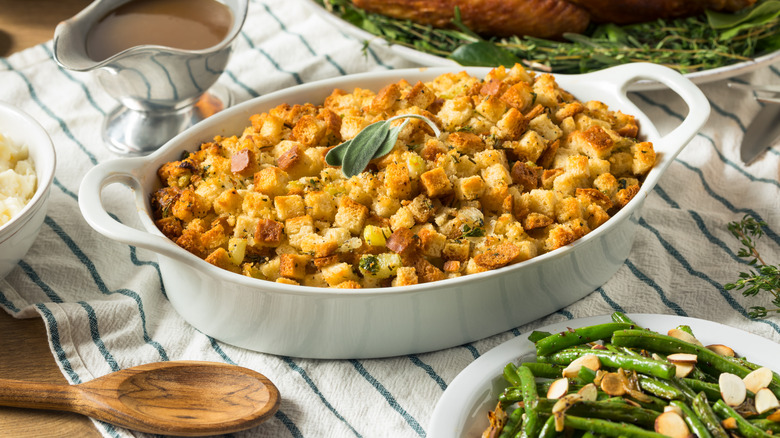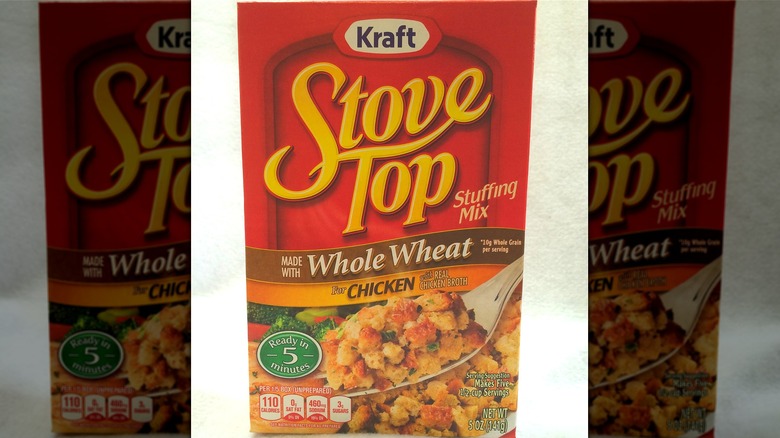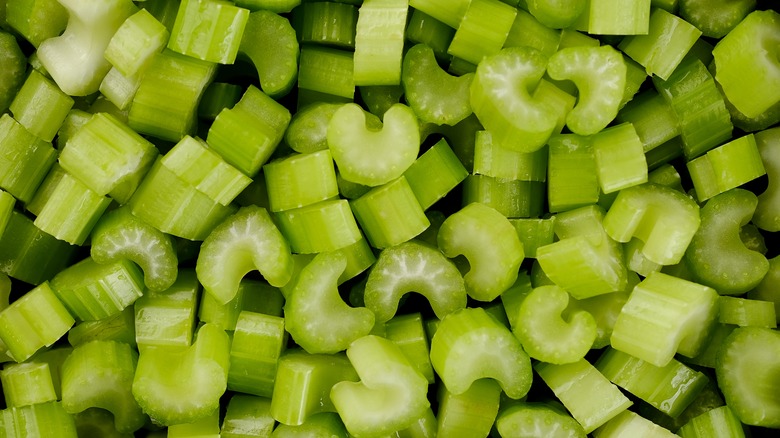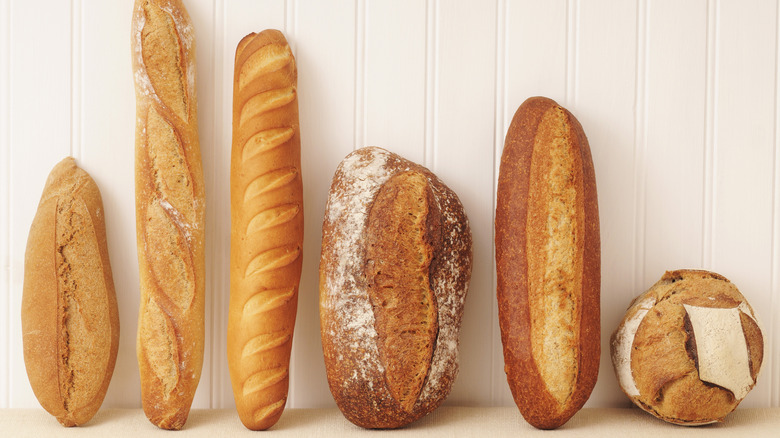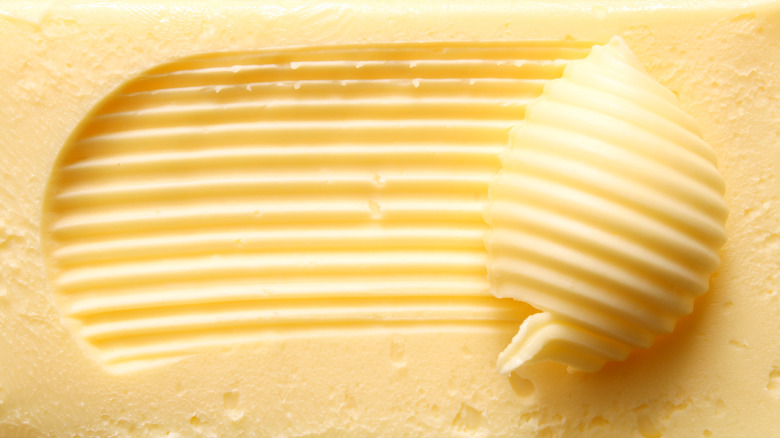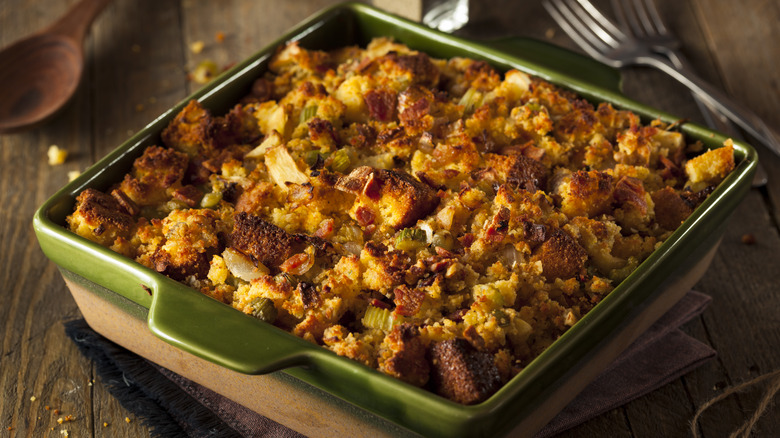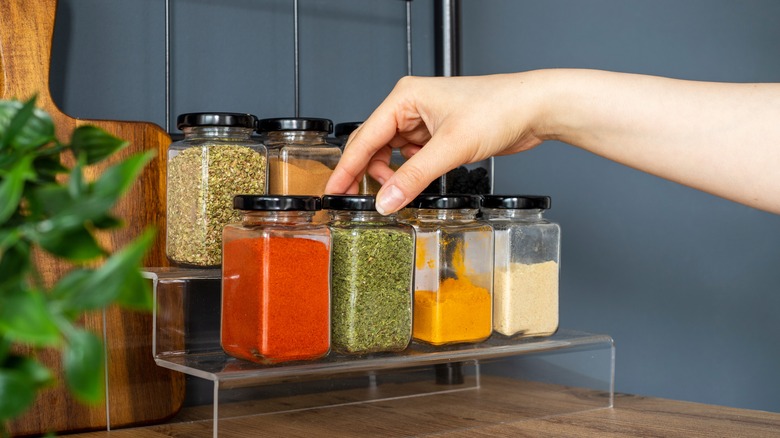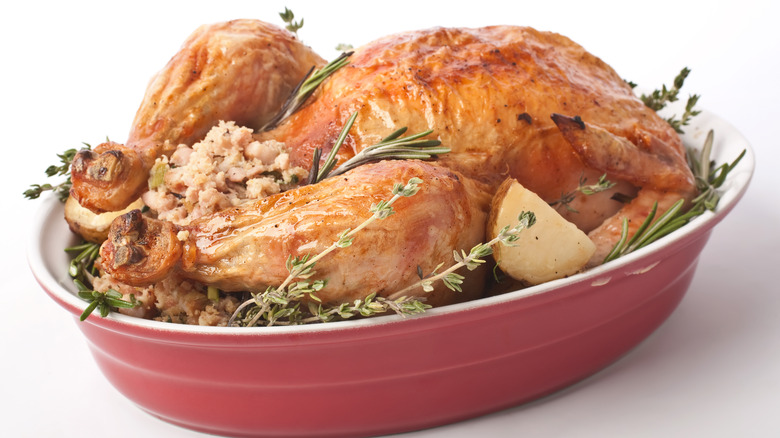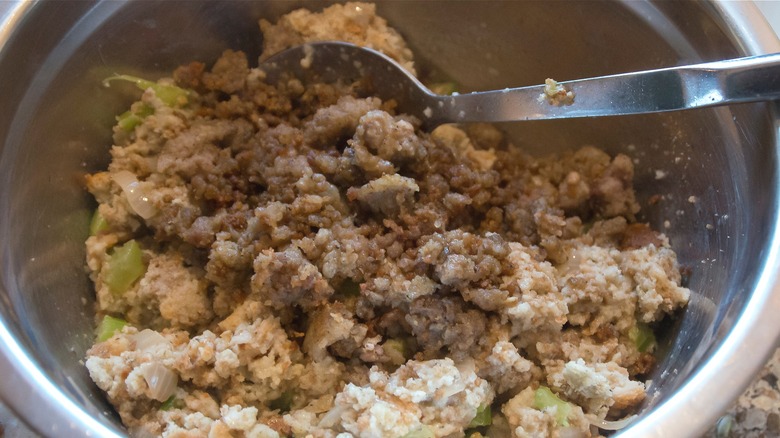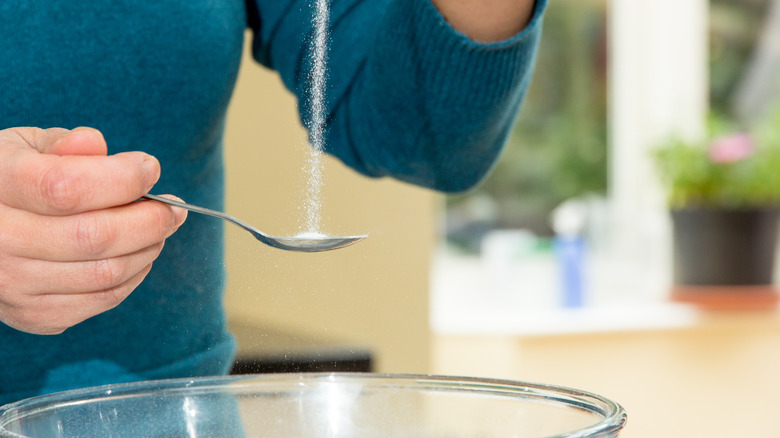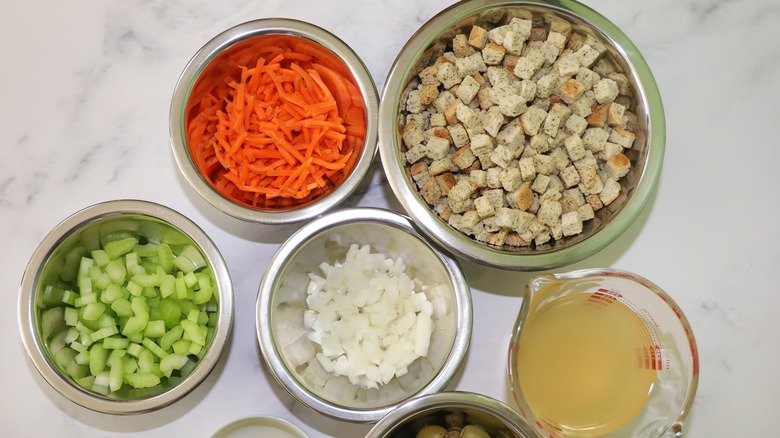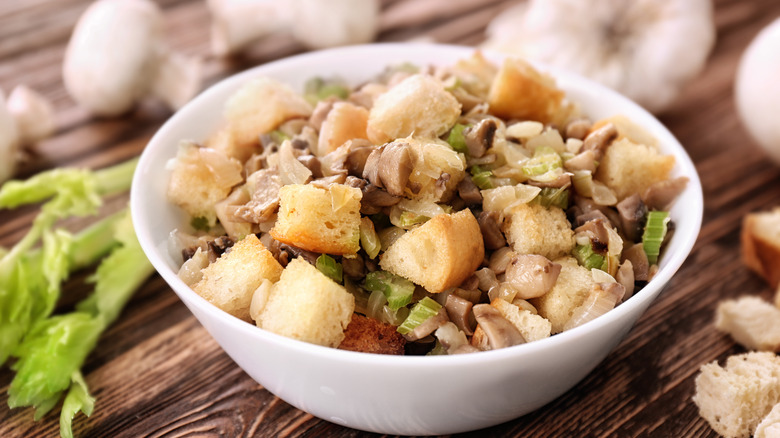The 15 Biggest Mistakes Everyone Makes With Stuffing
Imagine it's finally time to sit around the dinner table at your family's Thanksgiving celebration. You've been patiently waiting all day while the delicious aromas fill the whole house, increasing your appetite. Family members pass around various dishes, but you're most excited about the classic stuffing. Yet, once the stuffing makes it to your plate and you try a bite, you find it bland, soggy, or unpleasantly stale.
Of course, that's a major disappointment because stuffing usually only shows up on holidays. In a perfect world, stuffing is a balanced blend of bread cubes, butter, earthy herbs, vegetables like celery and onion, and some liquid to bind everything together. The edges and surface are buttery and crisp, and the center is fluffy.
However, several practices can result in lackluster stuffing, from the ingredients someone chooses to the amount of preparation they do before the big day. Then, how they bake it also plays a significant role. Fortunately, once you know the common errors that often trip people up with this famous dish, you won't have those issues arise yourself. Plus, you can always pass the information on to others so that their stuffing turns out incredible, too.
1. Not jazzing up boxed mixes
On hectic holidays like Thanksgiving, people often put so much energy into the turkey that they might put the stuffing on the back burner. However, even if you purchase a boxed mix to make things easier, it doesn't mean you can't upgrade it. You can build upon the simple base to make it more appetizing by including additional components. For texture contrast, add nuts such as toasted pecans, walnuts, pine nuts, or pumpkin seeds (which are quite fitting for the occasion).
The nuts provide a nice crunch, but you can also add chewy ingredients for variation, such as dried cranberries, apricots, or plums. Another option is to use brown butter instead of regular butter, which provides the stuffing with a more complex, nutty undertone. Lastly, you surely can't tell the stuffing came out of a box if you mix in seasonal autumn produce like root vegetables, pears, Brussels sprouts, butternut squash, or acorn squash.
2. Using raw vegetables
Whether making classic herb stuffing or experimenting with different versions, some folks make the mistake of not pre-cooking the vegetables. Even if you bake the stuffing, sometimes the oven time isn't enough for the veggies to reach the correct consistency because different types vary in cooking times. You also miss out on a deeper flavor when you don't soften them. When you cook vegetables in a fat like butter, they release savory aromatics that soak into the bread and improve the whole dish, which is what creates that familiar, comforting taste of home-cooked stuffing.
Simple traditional components like celery and onion only take a few minutes on the stovetop, so it's not a big deal. If you try more unique additions, such as broccoli or carrots, it's a different story because they're bulkier and take longer to cook. No matter what you use, chop the vegetables into small, diced pieces because it helps them to cook more evenly and have more flavor in the final product.
3. Using the wrong kind of bread
Many people might make the mistake of using fresh bread rather than dry or stale bread. It's understandable since most of the time, when you cook, you want to use the freshest ingredients possible. However, fresh bread doesn't produce the same texture because it doesn't absorb the liquid ingredients in the same way, leading to soupy stuffing. Luckily, numerous bread types are ideal for this dish, with white bread and cornbread being the most popular choices.
Nevertheless, sometimes people get creative with bagels, leftover buns, sourdough, or English muffins. Challah and brioche are also excellent choices since they have eggy, buttery flavors that pair well with the stuffing ingredients. Whichever one you go with, don't just slice it into uniform cubes but break it apart with your hands instead. This gives the dish a more natural and rustic look that people appreciate. Additionally, the broken bread pieces create a larger surface area for optimal liquid absorption and a golden-brown finish, so it's not just for looks.
4. Skimping on the butter
Home cooks often end up with dry stuffing when they omit the butter or replace it with a different, lighter alternative. The butter is there for a reason — it supplies much-needed moisture to the dish and helps the edges get nice and crisp, leading to a more enticing dish. Additionally, it's a mistake to use butter substitutes designed to have lower fat content because the fat is what makes butter so creamy and rich. When you use other products like margarine or vegetable oil spreads, they alter the dish's taste.
By all means, there's no harm if you use butter substitutes in everyday cooking or baking, but you shouldn't compromise on flavor or quality when it comes to holiday foods. For best results, use unsalted, sweet cream, or European-style butter. You can also grease your dish with real butter instead of cooking spray if you want to go the extra mile.
5. Adding too many mix-ins
Adding unique ingredients to stuffing assuredly makes it more satisfying to the palate and captivating for the eye, but some people take it too far with the mix-ins. First, the abundance of ingredients distracts from the herbs and bread, so it turns more into a hodgepodge casserole than a discernible Thanksgiving staple. Moreover, the main issue is that the binding ingredients can't do their job because too many other components are in the way, which causes crumbly stuffing with no structure.
Keep an eye on your ratios to prevent your stuffing from falling apart before it even reaches your plate. Try to follow your recipe as closely as possible, or if you are eyeballing it without a formula, the bread should take up most of the composition, with vegetables or other inclusions like nuts and dried fruit functioning as accompaniments. If you're unsure whether the stuffing has enough binding power, you can always toss in a couple of eggs, which help hold everything together.
6. Using bland liquid
Some homemade recipes call for water as the liquid in the stuffing, which is a huge mistake when you can use savory stock or broth instead. Stove Top brand stuffing, one of the most popular store-bought options, instructs people to add water with the butter and stuffing mix. Understandably, the pre-made products make things convenient, but it doesn't cost you any extra time to swap the liquid for something with flavor, even if the boxed mix contains a small amount of dried stock.
If you plan to make vegetarian or vegan stuffing, you can use vegetable broth instead of animal stock, so there's no excuse. Additionally, it's possible to use other liquids, such as half-and-half, which makes the stuffing rich and reminiscent of a savory bread pudding. If you are up for experimenting, some people swear by apple or orange juice (you can mix it with water or broth if you wish), which provides unique undertones to the dish. Of course, if your stuffing has apple pieces, the apple juice accentuates the fruity flavor. Meanwhile, orange juice is delicious in stuffing with dried cranberries and nuts.
7. Using dried herbs
Many folks might assume that poultry seasoning is the solution when they cook for a crowd and are in a time crunch. Although it is easier to sprinkle some dried herbs from a little spice jar, the few minutes it takes to chop fresh herbs are worth it. Typically, stuffing contains herbs like rosemary, thyme, or sage, which give the dish a warm, comforting taste. Then, parsley adds a light and refreshing twist to balance it out. Moreover, fresh herbs are more appealing because of their vivid color, whereas the dried stuff tends to blend in with the other components.
If your local grocery store runs dry on inventory around the holidays, or you simply want to take a shortcut, purchase as many fresh herbs as possible and supplement the remaining with dry. After all, when you use quality ingredients in cooking, it shows. Don't forget to chop them into small pieces to be evenly distributed throughout the mixture. Then, you can top the baked dish with a sprig of rosemary for an elevated presentation.
8. Not baking it separately
Undoubtedly, the term "stuffing" refers to how people traditionally stuffed their turkey or other bird with a mixture of bread and vegetables before cooking it. Some even argue that it's no longer stuffing if you cook it outside of the turkey, and you must call the dish "dressing" instead. Yet, over time, it's become more apparent that cooking the stuffing inside the turkey is one of the Thanksgiving short cuts that aren't worth it for both safety and quality reasons. This practice presents challenges because it can result in a longer cooking time or an unevenly cooked dish.
For instance, if the turkey is ready much longer before the stuffing, you need to continue cooking it, which results in less juicy meat and possibly a burned exterior. It's just too likely that one component ends up under or overcooked since it takes longer for the heat to reach the stuffing. If you want to stuff the bird for presentation purposes, you can always cook the side dish and turkey separately, then load it inside directly before serving it.
9. Adding the wrong amount of liquid
Although recipes are great guidelines to follow when you make dishes like stuffing, they can be the downfall for some home cooks who follow them too closely and put aside their best judgment. How quickly the bread absorbs the liquid is circumstantial because it depends on the type of bread you use and how well you dry it out. Therefore, it's best to gradually add it in segments instead of dumping all the liquid in at once. Give the bread a minute to soak it up like a sponge before you decide if it needs more.
The stuffing is ready to bake when the ingredients form together without being sopping wet. Use a knife to move some of the bread pieces aside so you can see the bottom of the bowl or pan to examine if there is excess liquid. If there is visible broth, do not put the dish in the oven, but try to fix it by including more bread and mix-ins. You might end up with more portions of stuffing, but at least it bakes into a dish with the perfect texture.
10. Over-seasoning it
Many people overdo the seasonings in their stuffing because they don't consider that the broth and other components already have a lot of sodium and flavor. For instance, animal stock has deep umami notes that soak into the bread. Then, the butter and cooked vegetables act as aromatics, which give the dish even more flavor. That doesn't include other add-ins like meats, whether you use pork, beef, or another type. And let's not forget the multiple fresh herbs that give the stuffing its earthy essence.
With all of that combined, it's a wise idea to be cautious when you introduce other seasonings, especially salt. You can always run a taste test, assuming that you already cooked the meat and haven't added any raw eggs. Then, it's easy to gauge if the food needs another dash of salt or spices. Remember, less is more because a small amount enhances the dish's natural flavors.
11. Incorrectly baking it
Surprisingly, there are many ways for people to mess up a simple stuffing during the baking process. Specifically, it might be too soft or dry if you take the wrong steps. But here's a hack to help you: use a baking sheet to take your stuffing to the next level. Since sheet pans are shallow, you can spread the stuffing so that the heat can directly reach more bread. On the other hand, deep dishes only brown the surface level, meaning the center of the stuffing might be soggy. The baking sheet trick also benefits you with a faster cooking time.
In addition to choosing the right cookware, whether or not you cover the stuffing is just as vital. If you leave it uncovered the entire time, it might burn, but if you cover it, you don't get the crispy golden pieces you want. The simple solution is to cover it for most of the baking time and then finish it with it exposed to the heating elements. You can always put it under the broiler if it doesn't initially become as crispy as you wish.
12. Neglecting to check the temperature
One mistake people make is assuming that the stuffing is safe to consume if it has enough color on top. Especially if their stuffing doesn't contain meat or eggs, it's easy for people to think that a food thermometer is overkill. You might be surprised that the U.S. Department of Agriculture states that no matter how you cook stuffing, it must reach a minimum of 165 degrees Fahrenheit before you serve it.
To check for doneness, insert the tool into the thickest part of the dish, usually the middle. Check a few different spots in the stuffing since some ovens cook unevenly, which leads to hot spots in some cases. It might go without saying, but if you plan to use the same thermometer for multiple different foods, you must properly clean it between them. In addition, if you cook the stuffing inside the turkey, it becomes a little trickier to check if it's ready, but the same rule applies: check more than one spot of the mixture, being extra cautious with examining the center.
13. Making it last minute
When people make stuffing for holidays, they likely have several other recipes that they are working on simultaneously that have their attention, too. Unfortunately, this might lead to the dish being overlooked and not turning out right. Although it's a relatively simple recipe, it benefits from prep. You can take different steps in the days leading up to the holiday to make the cooking day much more manageable.
First, you can transfer ripped bread pieces to a baking sheet and use linen to cover them. Allow them to dry out for a few days before you use them. This saves you from having to frantically dry the bread in the oven when you need the appliance for other foods. Secondly, take the time to make homemade stock or even chop and cook the vegetables the day before. This way, you can leave the stove-top burners available for dishes that require last-minute cooking to taste fresh.
14. Combining the ingredients too soon
Sadly, some folks might not realize the importance of timing when making stuffing. Even if you prepare some of the ingredients the day before, waiting to mix everything together until the last minute is crucial. When you merge the wet and dry ingredients prematurely, the bread loses shape and becomes soggy over time. As a result, the final product has a funky texture and looks less appetizing.
You want distinct bread pieces to show rather than it becoming one mushy mixture. Furthermore, the USDA states that it is an unsafe practice to store raw stuffing in the refrigerator. If you want to combine the ingredients and have them ready to bake, you must freeze the entire dish. Then, cook the stuffing from frozen, as it is also dangerous to thaw the uncooked food. Ultimately, it is much less complicated and risky if you mix and then bake it immediately (and it tastes better, too).
15. Making too little
Surely, there's nothing worse than running out of food on a big holiday. If you serve the food buffet-style and people choose their own portion sizes, you might run out of stuffing before the folks at the end of the line even get a chance to try it. Additionally, one mistake people might make is not accounting for the fact that many people have seconds. This issue can be solved by making more stuffing than you need and then figuring out how to use the leftovers later.
Depending on how many guests there are, you can always divide up the leftovers and send an equal amount home with everyone. But, if you end up with all the remaining food, there are fantastic Thanksgiving leftover recipes that incorporate stuffing, ranging from sandwiches to casseroles. One thing to keep in mind is that stuffing only lasts around four days when you properly store it in the refrigerator, so you need to use it quickly before it goes bad. The freezer extends its shelf life up to a month, which gives you more time to decide how to use it.
